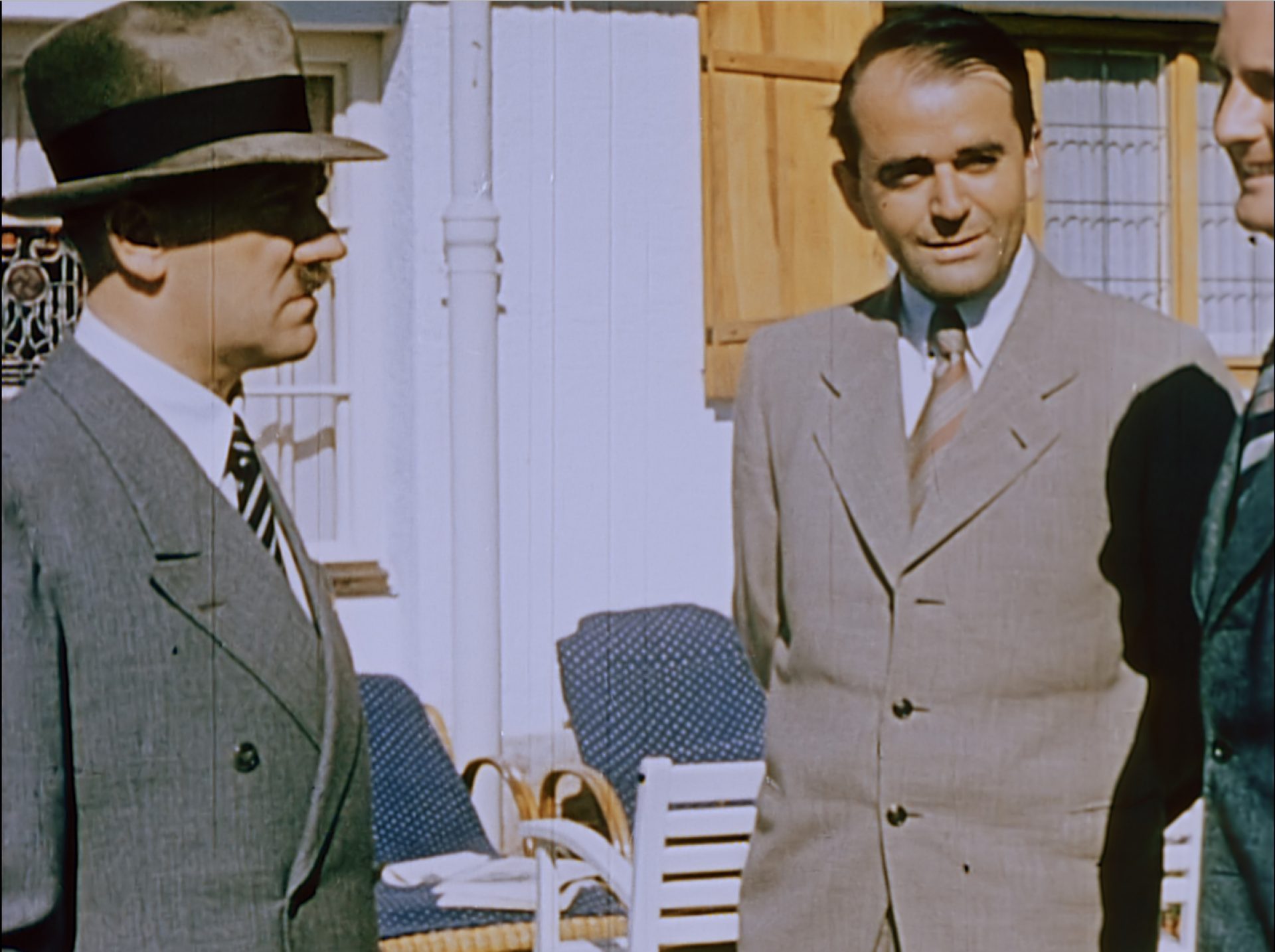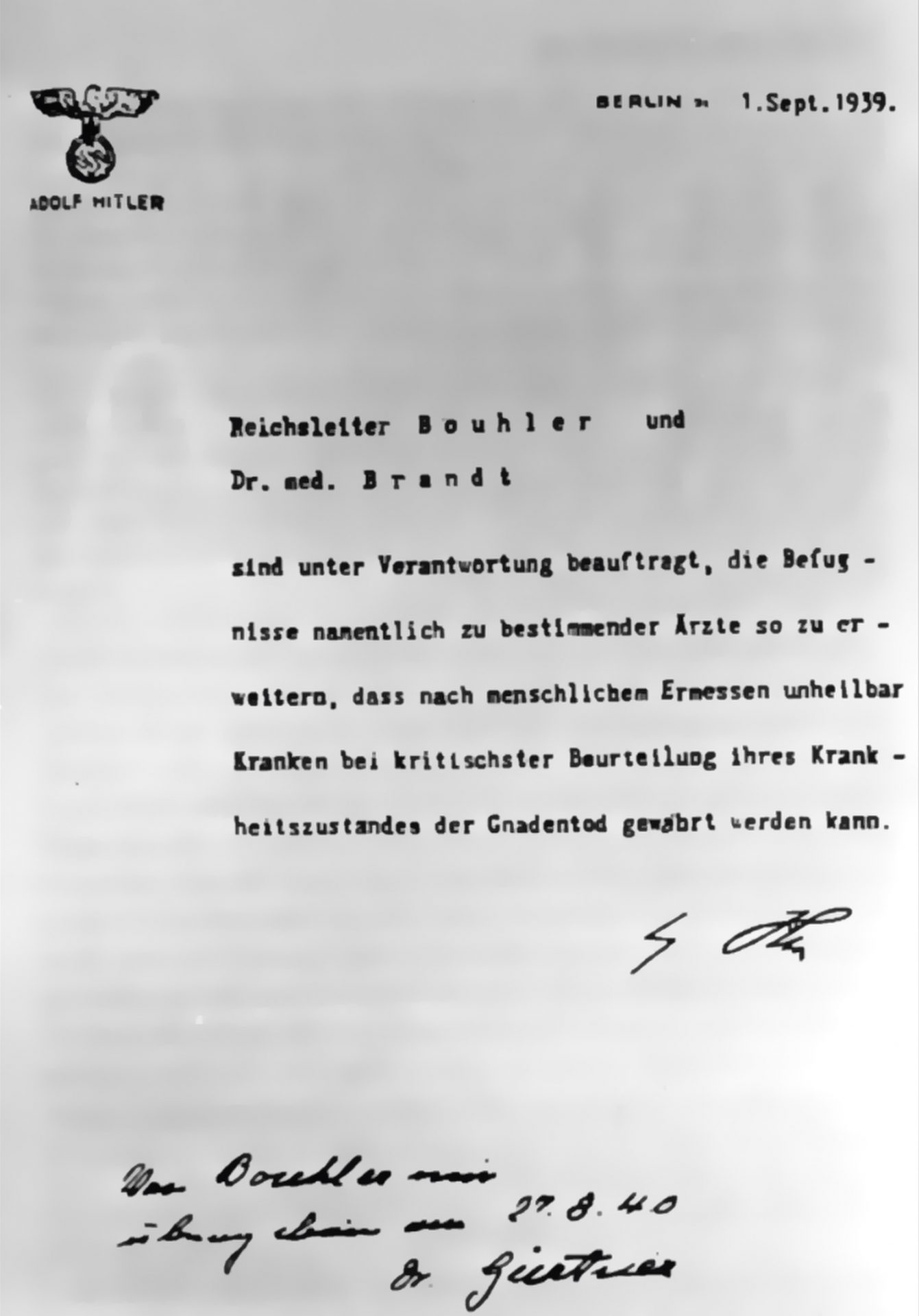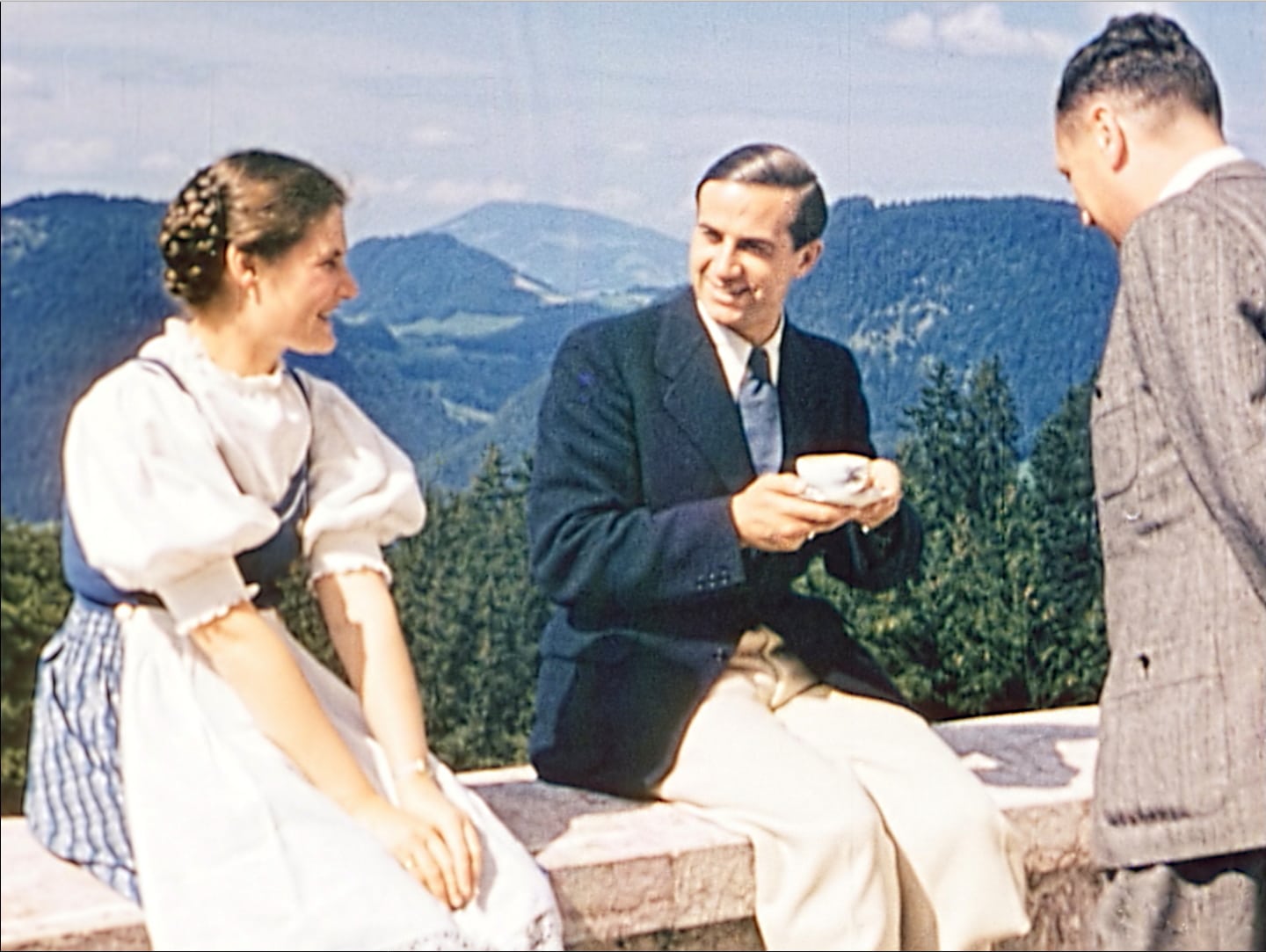Films by Mrs. Hitler
The films by “Frau Hitler”, by Eva Braun, are among the few testimonies of the everyday life of Adolf Hitler and the powerful of the Third Reich. The films were shot in the years after 1936. They mainly show scenes on the terrace of the Berghof am Obersalzberg in Berchtesgaden, but also their excursions in Upper Bavaria or trips to Scandinavia or Italy. Hitler’s entourage at Berghof is captured in many scenes. They present the harmless face and behaviour of a society of murderous followers of the leader of the Third Reich. One example is the smart young man Dr. Karl Brandt, Hitler’s on-call doctor. Since 1939 he has been responsible for tens of thousands of euthanasia murders. In 1945 the Berghof is bombed, another film from May 1945 shows the ruins of the Obersalzberg area.
The “Photohaus Hoffmann” in Munich’s Amalienstraße has just moved into 25 new, larger business premises. On a Friday evening at the beginning of October 1929, a man arrives, he is in his early forties and at one meter 75 rather average, the few steps from his office in Schellingstraße across to visit his friend and party comrade Hoffmann in the new business. He enters the shop and Hoffmann asks him into the next room. As so often, the visitor is nervous and restless. Hoffman thinks a snack will do him good. That’s why he calls his new apprentice to get beer and Leberkäs from a nearby innkeeper.

Leberkäs and beer for the “Wolf
When the young trainee returns with jugs and meat cheese, the men stand at the light table bent over new photographs. Hoffman fetches plates and cutlery and asks the trainee to sit with them.
Eva Braun is just 17, has finished her commercial school in Munich and started her apprenticeship a week before. The special guest is called “Herr Wolf”. As Hoffmann remarks, he has less eyes for his meal than for the girl he is staring at all the time. Since it is already late, Eva wants to go home. The visitor offers to drive her home in his cabriolet, but she refuses.
The following morning, her boss Hoffmann asks if she had not recognised Mr Wolf? “Have a look around, he is Adolf Hitler, who hangs here on so many photos of us”. For example – reconstructed from stories told by the Braun family – a story begins that will be one of the best kept secrets of the Third Reich. And which leads to the films of “Frau Hitler”.
A month of fate
October 1929 is a historically significant month. Hitler and his NSDAP were still a small splinter party in Germany. Only 2.8 percent of the voters had voted for the party in the Reichstag elections the year before. But Hitler’s party already has rich financiers. And a few days after the first evening meeting between Adolf Hitler and Eva Braun, the New York stock exchange crashes. The collapse of the world economy becomes a chance for the populist Hitler to become an important political power factor in the country overnight.
For he now has access to the mass press of the Hugenberg newspaper group and can drum his message all over the country: I, the Führer, am making Germany great again. The Mummenschanz in party uniforms pretends to be serious, secure and strategic. The party is a male alliance, arm of a military organization, held together in the minds of the narratives of the front fighters of the world war. “My struggle” – with success. In 1930, the NSDAP achieved 18 percent of the votes. Today we would call that the success of a populist.
For the simple mind of Hitler, who himself believes in his role as Redeemer with religious fervour, this success may have been connected with the entry into his life of the blonde Madonna figure of Eva Braun.

Berchtesgaden
A few years earlier, in 1923, Adolf Hitler had come to Berchtesgaden for the first time to meet his party colleague Dietrich Eckart. Eckart was the editor of the party newspaper “Völkischer Beobachter”. After his conviction and imprisonment in Landsberg, Hitler returned to the mountains immediately after his release. 1926 he writes there on volume 2 of “Mein Kampf”. His preference for young women is already evident here. Mizzi, the 16-year-old Maria Reiter, succumbs in the autumn of 1926 to the “stabbing gaze” of the party leader, who is 21 years older. Half a child, half a woman, an easy-to-control playmate, an immaculate Madonna, after that is the “wolf”. Until 1931 the unequal liaison lasts, with which the girl let “everything happen with (herself)” according to her own statement. However, whether “everything” actually happened, whether Adolf Hitler seduced the minor, can no longer be clarified.
In 1928 Hitler was able to permanently rent a holiday home on Obersalzberg, the Haus Wachenfeld. And again a young woman comes into play. His niece Geli Raubal, whose guardian he is, becomes entangled in a tragic love affair with her uncle. She ends in suicide in 1931.

Eva Braun films her lover Adolf Hitler…
Hitler comes to money and power and buys the house Wachenfeld in 1933. Now the idyllic holiday home is transformed into a stately summer residence according to Hitler’s specifications. The Obersalzberg becomes a restricted area. The Führer-Versailles of the dictator in the mountains.
A court belongs to a pleasure palace. Eva Braun is also part of the party at the Berghof. A relationship has developed between the wolf, Adolf Hitler, and the 33-year younger since the first encounter in October 1929. After the death of Geli Raubal, Eva Braun became Hitler’s new muse and lover. Simple and nice, finds Albert Speer. A simple Munich girl. She is 19 years old, he is now 42. Eva Braun also makes two suicide attempts. Because the party leader does not make the relationship public. Marriage is out of the question. But he lets his relationship cost him something, buys Eva Braun a house, provides her with a princely income. Keeps her in the golden cage “Berghof”.
… in colour
Heinrich Hoffmann, Hitler’s in-house photographer, was one of the first to gain access to the new Agfacolor colour films developed by AGFA in 1936 in the mid-1930s. Eva Braun is able to capture the scenery at Obersalzberg with this film material. Frau Hitler’s films, which were kept top secret during the Third Reich, allow an unusually close look at Hitler. The films were found and confiscated in 1945 by American soldiers in Eva Braun’s villa at Wasserburgerstrasse 12 (now Delpstrasse) in Munich’s prestigious Bogenhausen district and in Austria.
In the first part of our cut you can see Hitler in white NSDAP party uniform in conversation with his adjutant SA-Gruppenführer Wilhelm Brückner in brown uniform jacket. Albert Forster, then an important official of the German Labor Front, can also be seen with his back to the camera. Hitler had four adjutants who can be seen in other parts of the films. There were also three military adjutants. One sequence shows Hitler in a brown uniform, an excursion in a convertible and a bumpy scene at the staircase to the Berghof building. After all, the always irritable dictator appreciates his girlfriend’s passion for film and plays his role as ruler in the film well-behaved. Often for the pleasure of those involved, who come into the picture by chance. It is said that at the Berghof Hitler felt like he was part of the family. Private shots, however, look different. There is no casualness to be seen. Hitler tries like a bad actor to play the nimbus of the leader infallibly led by Providence.v
Important protagonists
Hitler pats the children of his architect and later arms minister Speer, Albert (junior) and Hilde. We see a smart Albert Speer on the balustrade of the Berghof terrace. Speer, by the way, ridiculed the building, which according to Goebbels was Hitler’s favourite place and his real home, as the work of a dilettante. What was meant was Hitler himself, who had his architectural ideas realised there. The Speer couple nevertheless became regular guests at Obersalzberg and belonged to the closest circle around the dictator. There was the power and the money. And power is a beguiling plant. Albert Speer’s arrogance becomes visible on the film. Johanna Morell, wife of Hitler’s doctor, can also be seen. And Foreign Minister Joachim von Ribbentrop. A photograph from the summer of 1938. Then again Speer and Gerhard Engel, who was the liaison to the General Staff of the Army.
The colourful film show…
Hitler tried to hide his relationship with Eva Braun from the public. Eva Braun was not allowed to attend any official reception in Berlin. When visitors came, she, the mistress, was also hidden on the Berghof in the next room. Eva Braun attempted two suicides to escape this difficult double life. The first in 1932, even before Hitler had come to power, the second in 1935. An outcry of deepest despair. Because Hitler must have felt his love for Eva Braun as a flaw and weakness. It is said that he treated her contemptuously in the circle of the faithful of the Berghof.
… for distraction?
But she seems to have found joy and happiness in the magnificent Bavarian mountain world around the Obersalzberg and on summer excursions to the Bavarian lakes. Because Hitler enables her to lead a luxurious life in idleness. She has cut together her private film footage as “Bunte Filmschau”. A film clip shows a bathing excursion with the Braun family, the parents Franziska and Friedrich and Ilse, the younger sister Evas and secretary of Albert Speer, the actress Else von Möllendorff, Annie Rehborn-Brandt and Karl Brandt, Sofie Stork and her clique in the sports pool Fleischmann, Steinebach am Wörthsee. The film title “Die bunte Filmschau” was drawn by Sofie Stork.

Dr. med. Karl Brandt can be seen on many photographs. He belongs to the regular crew of the Berghof. Since 1934 he was a constant companion of Hitler as a surgeon, the “accompanying physician”. If Hitler had been involved in an accident, he should help immediately. The young, slim, tall man is an SS group leader and doctor at the Berlin University Surgical Clinic. In 1939, Brandt was personally commissioned by Hitler to lead the euthanasia program.
A thousandfold murderer
Brandt was responsible for the murder of thousands of mentally handicapped people. The idea of defining the value of a human life “at human discretion” is not an invention of the National Socialists. Eugenics had been an internationally recognized research discipline since the end of the 19th century. Francis Galton, the cousin of Charles Darwin, had founded this scientific teaching. High-quality genes were to be promoted, inferior ones excluded. From here, euthanasia, which can mean either euthanasia or deliberate killing, was also scientifically legitimized. Karl Brandt later tries to persuade himself that the responsibility for a killing lay with the doctor treating him.

A friendly looking intelligent young man
How can the scientific discourse in society slide in this gruesome direction? There was hardly any discussion in the medical profession of the Nazi era about the admissibility of killing programs. Under the conditions of the Nazi society, what did it mean to “extend the powers of physicians to be appointed by name” in such a way that “at human discretion” “at the most critical assessment of their state of illness” “grace death can be granted”? Well over 100,000 people were killed at the end of these instructions, as Braun himself confirmed during his interrogation. Scientific arguments serve to destroy humanity. Braun was therefore sentenced to death and executed in 1948.
Also today we can only act correctly in the discussion of euthanasia if we are aware of the influence of the circumstances of our environment on our judgement. But science is not value-free, not “true”, but always a child of its time. In this respect it is a deceptive basis, especially when it comes to the decision about life and death.
The women of the Berghof
The Berghof became Hitler’s most popular and important residence in 1935. Eva Braun’s films immortalize a number of women who belonged to the court. The NSDAP originated from the military male unions of the time of the First World War. The propaganda of the NSDAP saw the role of women as helpers and fellow combatants of men. Hitler was always able to cast a spell over women. The ecstatic scenes at NSDAP major events are well-known, at which women enthusiastic about leadership are close to powerlessness.
Little dots on the mountain
Eva Braun has titled a film sequence “Pünktchen am Berg”. “Pünktchen” is the Munich actress Else von Möllendorff. She was a close friend of Eva. You can also see Gerda Bormann, Herta Schneider and Evas Braun’s sister Gretl. Casual posing of the protégés of a powerful man who is about to reach for world domination. He has tens of thousands of Jewish families humiliated and destroyed without hesitation at this time, he does not shrink from any act of violence, he plans the great war that will cost millions of victims and destroy Germany as well as Europe. The little dot on the mountain – despite all its harmlessness in detail a disturbing document of naive normality.
Fit für den Führer
Einige der sommerlichen Filmaufnahmen von den oberbayerischen Seen zeigen Eva Braun bei Fitnessübungen. Also kann man annehmen, dass sie Hitler mit diesen Aufnahmen beeindrucken wollte. Wie immer die Beziehung zwischen den beiden aussah, Körperkult und Sex spielen für Hitlers Muse eine große Rolle.
Die First Lady? Offizielle Besucher
Die Rolle der “First Lady” des Dritten Reichs spielt seit 1931 Magda Quandt, die später Josef Goebbels heiratet. In Berlin zeigte sich Hitler auf offiziellen Empfängen an ihrer Seite, sehr zum Missvergnügen seines Propagandachefs. Goebbels bemerkt über Hitler, er habe bei Frauen kein Glück, weil er ihnen zu weich sei. Jedoch gehört zum Mythos Hitler seine Rolle als alleinstehender, im Prinzip für alle Frauen erreichbarer Hohepriester. “Wenn das der Führer wüßte” lautete ein Topos im Volk, mit dem die Untaten, die Korruption und das Versagen der NS Funktionäre zwar bemerkt, Hitler und sein totalitäres System aber entschuldigt wurden. Deswegen wurden zig-Tausende Eingaben, Beschwerden und Bittschriften aus der Bevölkerung an den Führer geschickt, im naiven Glauben an den gerechten Führer und Messias.
Nur auf dem abgesperrten Gelände des Berghofs konnte Hitler eine private Rolle spielen. Die Lage über dem Berchtesgadener Tal entsprach seinem Selbstbild als weitsichtiger Visionär und Künstler. Der Berghof wurde mit den ausgedehnten Aufenthalten von Hitler zu einer Art Regierungssitz. Für die Reichskanzlei unter Hans Heinrich Lammers wurde eigens eine Aussenstelle in Bischofswiesen errichtet. Der Berghof war mit Telefon und Fernschreiber rund um die Uhr erreichbar. Die Sekretärinnen und Adjutanten arbeiteten im Gebäude. Dennoch liebte Hitler es, sich hier unerreichbar zu machen. Andererseits gingen Parteigrößen ein und aus und offizielle Staatsbesuche gab es auch am Berghof.
Ein offenes Geheimnis?
Die Rolle von Eva Braun konnte nicht verborgen bleiben. Offiziell wurde Eva Braun als Hitlers Sekretärin geführt. Und vielleicht gab sie sich als Angestellte der Firma Heinrich Hoffmann und Fotografin aus, wenn sie Filmaufnahmen der Besucher machte? Die Aufnahmen zeigen bei sorgfältiger Durchsicht jedoch, dass niemandem im Führungszirkel des Dritten Reichs die Rolle von Eva Braun verborgen geblieben war.
Mussolinis Aussenminister Graf Galeazzo Ciano kokettiert auf einem Foto mit ihr. Und Josef Goebbels grüßt jovial in die Kamera, auch Himmler scherzt entspannt. Dem mächtigen NSDAP Schatzmeister Franz Xaver Schwarz wirft sich Eva kokett an die Brust. Er oder Martin Bormann steckten ihr Kuverts mit Bargeld zu. Hermann Esser, Parteibuch Nummer 2 der NSDAP, führt sie feixend am Arm.
Nach dem Ende des Naziregimes wird Esser versuchen, mit einem Manuskript “Frauen um Hitler” Kasse zu machen. Schon 1938 wurde in einer tschechischen Zeitschrift auf Eva Braun hingewiesen. Jedoch hat der amerikanische Reuters Korrespondent in München, Ernest Pope, der einige Kenntnisse des Nachtlebens der Münchner NS Prominenz in den Jahren vor 1940 ausbreitet, zu Eva Braun nur wenig berichten können. Die deutsche Öffentlichkeit erfuhr von diesen Vermutungen allerdings nichts. Weil, so Josef Goebbels , der Führer “sich voll und ganz der Nation widmet und kein Privatleben hat …”. Aber die Neugier der Deutschen war risengroß, Tausende defilierten in den Sommerwochen am Zaun des Berghofs.
Das Ende
Am 28. April 1945 diktierte Hitler seiner Sekretärin Traudl Junge: “Da ich in den Jahren des Kampfes glaubte, es nicht verantworten zu können, eine Ehe zu gründen, habe ich mich nunmehr vor Beendigung dieser irdischen Laufbahn entschlossen, jenes Mädchen zur Frau zu nehmen, das nach langen Jahren treuer Freundschaft aus freiem Willen in die schon fast belagerte Stadt hereinkam, um ihr Schicksal mit dem meinen zu teilen.” Eva Braun wird für 24 Stunden zu Hitlers Ehefrau. Dann enden beide durch Selbstmord. Zeitgleich am 25. April wird der Berghof von britischen Bombern in Schutt und Asche gelegt. Amerikanische Soldaten filmen Anfang Mai 1945 die gespenstische Szenerie.
Beitrag: Stephan Bleek. Lizenzierungsanfragen für Texte, Film- und Fotomaterial bitte an zb Media.

Leave A Comment